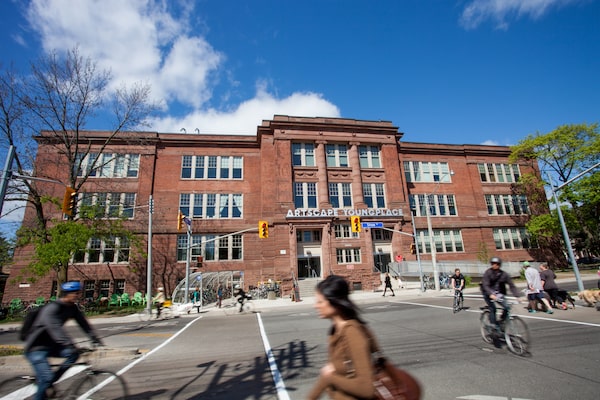
Toronto-based artist Barbara Astman and her husband own about 1,000 square feet in Artscape Youngplace, a former downtown Toronto public school that was converted to artist studios in 2013.
As a celebrated Toronto-based artist, Barbara Astman loves her maker space, but there are complications with owning her own studio.
“In theory, the whole idea of a maker space is wonderful. It’s a building with sections dedicated for people to make or build things,” she says.
Ms. Astman, whose photo-based collages are displayed around the world, owns, along with her husband, about 1,000 square feet in Artscape Youngplace, a former downtown Toronto public school that was turned into maker spaces for artists and craftspeople in 2013.
Repurposing old assets is a great way to build community and culture, and that’s something that people really value today.
— Benjamin Shinewald, president and chief executive officer of BOMA
In Toronto and other cities, maker spaces in commercial and institutional buildings are not unusual, but not exactly widespread either. Both developers and potential occupants are intrigued by the idea of making room for people to create.
“Repurposing old assets is a great way to build community and culture, and that’s something that people really value today,” says Benjamin Shinewald, president and chief executive officer of BOMA, umbrella group for building owners and maintenance operators across Canada.
Maker space can be of interest to commercial developers because they make projects more attractive to other prospective commercial and retail tenants and can enhance the value of residences if housing is included in projects.
The reality, though, is that maker spaces are not yet mainstream features of new commercial developments. There isn’t even consensus on what a maker space is.
In Houston, Tex., for instance, the East End Maker Hub, a US$38-million, 300,000-square-foot space, provides room for sewing and leatherwork, ceramics, printmaking, painting and jewelry-making.
Primarily a hub for small businesses that make goods, its developers expect it to create 1,000 new companies in the Houston area within five years and add new opportunities for jobs and skills in advanced manufacturing for local workers.
“It’s for people in the neighbourhood who need a good space for their business at a good price and on stable terms,” says Patrick Ezzell, president and chief executive officer at Urban Partnerships Community Development Corporation, the Houston organization that assembled the maker space.
In Colorado, another maker space focuses more on artists. The Manitou Arts Center in Manitou Springs offers wood and metal shops, ceramics, a predigital photo darkroom, paper and printmaking equipment and dyeing and textile facilities.
“The art centre supports the model of minimizing the artists’ upfront investments so they can take artistic risks instead of financial ones,” says Natalie Johnson, the centre’s executive director and founder.
The challenge is to keep up with demand, Ms. Johnson says. “We only have space for about 20 studio artists, although you can become a member for $50 a month and use our equipment 24/7.”
In Toronto, many of the best-known maker spaces, including Ms. Astman’s building, are administered by Artscape, a not-for-profit organization.

Artscape works with artists, communities and public-policy groups to connect artists to developments such as the Artscape Wychwood Barns.Ted Chai Photography
Artscape works with artists, communities and public-policy groups to connect artists to developments and renewal projects.
The organization’s maker spaces are popular, but subject to the vagaries of the commercial marketplace. One of the best-known projects was its leasing of some 50,000 square feet of space in the historic Distillery District, which was revitalized in 2003.
For two decades, Artscape Distillery Studios provided maker space at below-market rates for about 70 painters, sculptors, wood and metal workers, fashion designers and performers.
In December the owners of the Distillery District ended Artscape’s master lease and told the organization the artists would have to move out.
“Our 20-year head lease was, and is, scheduled to end in 2022, with no option to renew,” Artscape told its artists in a letter posted online to tenants and supporters.
The master lease was to end this August anyway, but the owners asked Artscape to move people out early where possible so they can repurpose the space for other uses such as retail.
“The partnership agreement at the Distillery was not set up in a way that guaranteed long-term security,” Artscape said. Letting artists buy space, as Ms. Astman has done, is one possible solution, but it brings challenges too.

Ms. Astman's studio is located at Artscape Youngplace.Barbara Astman
“As someone who has bought a maker space, at some point you come to the reality that you’re in a commercial building,” she says. “That means utilities, internet costs and property taxes are all at commercial rates which are much higher than non-commercial.”
These commercial costs are tolerable, if not ideal, for a successful artist like Ms. Astman, also a recently retired professor at Ontario College of Art & Design University. The costs can be out of reach for up-and-coming artists, though, she says.
“Another result of artists having to pay business rates for services is that we see fewer makers in the maker spaces like my building,” Ms. Astman adds.
“A lot of people are using their spaces for businesses, yoga studios – commercial activity in a commercial building, I guess.”
Ms. Astman says she would like to see Toronto and other cities look at developing a special category for artists’ maker spaces, something that is not residential, but not commercial either and doesn’t get hit by commercial taxes and rates.
Artists need places to create, she says.
“When I was starting out, I rented and I didn’t worry, but at some point, you want a room of your own.”